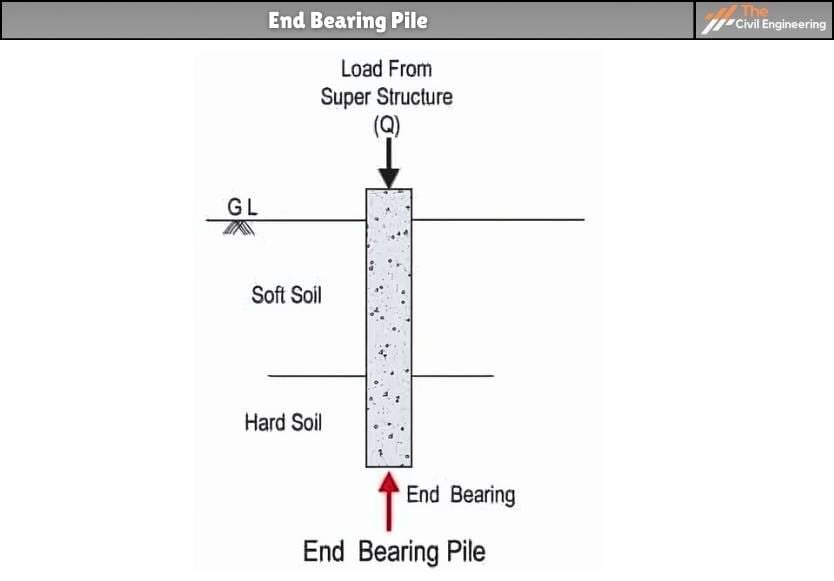1. Overview
Foundation is an important component of any engineering work that greatly determines the strength and stability of the entire structure. Foundation acts as a medium to transfer the load from the superstructure to the underlying ground. In general, foundations can be classified as shallow foundations and deep foundations. It is suitable to construct a shallow foundation when the surface soil has acceptable or adequate bearing capacity. On the other hand, a pile foundation is suitable when the surface soil is weak and thus the foundation has to be taken deep down where the soil has adequate bearing capacity. One such example of a deep foundation is End Bearing Piles which has been briefly discussed below.
2. Introduction
End bearing piles are the type of piles that are based on the mechanism of load transfer through the bottom tip of the pile itself.
End bearing piles are also commonly known as point bearing piles.

The end bearing piles are driven into the ground such that the bottom end tip of the pile rests at the intermediate layer between the weak soil layer and the strong soil layer.
On account of this end bearing piles develop most of the bearing capacity at the bottom tip itself. Thus, end bearing piles act as a column and transfer the load coming from the superstructure to the underlying soil.
The bearing capacity of such pile can be easily determined by multiplying the area of the bottom tip of the pile and the bearing capacity at that particular depth of soil where it rests.
Then, considering a certain factor of safety, the diameter of the pile can be determined.
3. Suitability of End Bearing Piles
It is desirable to use pile foundations in the following cases:
1. The surface soil layer is weak and cannot resist the load of the structure and undergoes excessive settlement.
2. When the structure to be constructed consists of very heavy concentrated loads such as in the construction of high-rise buildings, water tanks, bridges, etc.
3. When the groundwater table is relatively high.
4. When the construction has to be done on the riverside, river bed, or seashore where there is an increased risk of scouring.
5. When other types of foundations are not feasible or expensive.
6. When a canal system or deep drainage structure exists nearby the construction site.
4. Benefits of Using End Bearing Piles
Some of the benefits of using an end-bearing pile foundation can be listed as follows:
1. It is advantageous when the foundation has to be drilled through hard rocks or tough surfaces.
2. It is suitable for deep installations and is long-lasting.
3. Pile foundation can be pre-ordered as well as customized according to the need.
4. It is desirable even for wetland constructions and for all sizes of land construction.
5. It facilitates reduced construction time.
5. Applications of End Bearing Piles
The major application areas of end-bearing pile foundation are as follows:
1. High Rise Buildings and Towers:
End bearing pile foundation is highly desirable for the construction of high-rise buildings and towers.
It is efficient even in the constructions where the settlement is excessive as such piles greatly minimize the settlement.
2. Water Tanks and Reservoirs:
End bearing piles are highly suitable for the construction of water tanks and reservoirs.
3. Bridges:
End bearing piles can withstand very high loads efficiently and thus are used for the construction of bridges.
6. Determination of Bearing Capacity of End Bearing Piles
1. Schmertmann Method
This method of the determination of the bearing capacity of end-bearing piles was proposed by Schmertmann.
This method uses the following relationship to determine the unit tip (end) bearing capacity of the pile (qt) from the cone tip resistance:
qt = ( qc1 + qc2) / 2
where,
qc1 = the minimum of the average cone resistances of zones ranging from 0.7D to 4D below the tip of the pile
qc2 = the average of minimum cone tip resistance over a distance of 8D above the tip of the pile.
D = Depth of the end bearing pile
2. Tumay and Fakhroo Method
This method is used to determine the ultimate pile capacity of end-bearing piles, particularly in clayey soils. The relation used is as follows:
qt = ( qc1 + qc2) / 4 + (qa/2)
where,
qc1 = average of the qc values at 4D below the tip of the pile.
qc2 = average of the qc minimum values at 4D below the tip of the pile.
qa = average of the qc minimum values at 8D above the tip of the pile.
7. Advantages of End Bearing Piles
Some of the advantages of the end bearing piles can be listed as follows:
1. They have a higher resistance to settlement in comparison to other types of piles such as the floating pile. Due to this reason, the end bearing piles are highly desirable for the foundation of the multi-storied building.
2. They are suitable for most construction sites. They can also be molded as per the desire.
3. Such piles can also be prefabricated into any length, shape, and size and directly be transported to the site, hence reducing the time of completion.
4. They also offer high resistance to failure due to buckling in weak soil.
5. The cost of the end bearing piles can be duly optimized as its length can be specified based on the depth of the firm soil layer.
8. Disadvantages of End Bearing Piles
Some of the disadvantages of the end bearing piles can be listed as follows:
1. Heavy machinery and equipment are required for the construction or installation.
2. Sometimes, the soil surrounding the piles may stick on the surface of the pile thereby causing the development of negative skin friction.
| Read More: Pile Foundation |
| Read More: Grades of Concrete |
